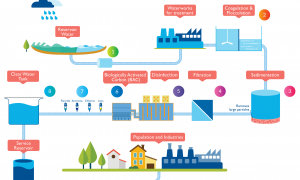🕑 Reading time: 1 minute
A fishway or fish ladder is a waterway constructed on or around a natural or artificial obstruction to provide a passageway for fish and other aquatic species. The construction of fishway allows a seamless migration for the aquatic species despite the obstructions like dams, culverts and waterfalls, which otherwise would have affected their migration and therefore their survival.
The 7 different types of Fishways or Fish Ladders and their characteristics are explained in this article.

Contents:
Types of Fish ladder
Different types of Fish ladders are as follows :
- Pool and Weir fish ladder
- Pool and Orifice fish ladder
- Vertical slot fish ladder
- Baffle fishway
- Rock ramp
- Fish elevator
- Siphon fishway
1. Pool and Weir Fish Ladder
A pool and weir fishway or fish ladder is a widely known fish pass structure. It consists of a series of small overflow weirs and pools of regular length. The pools are constructed in the form of steps and these pools are divided by overflow weirs.

In this case, fish need to jump from one pool to another to migrate to the upstream. Pool and weir fish ladders are suitable for all types of structures either it is small scale or large scale. However, they require a large space to construct.

2. Pool and Orifice Fish Ladder
Pool and orifice fish ladder is almost similar to pool and weir fish ladder and the only difference, in this case, is the overflowing weir is provided with a submerged orifice within its body. Hence, in this case, the fish can travel to upstream by just passing through each orifice rather than jumping over the weir crest.

3. Vertical Slot Fish Ladder
Vertical slot fishway is another variation of pool and weir fishway. In this case, the weirs are replaced by walls with vertical slots so that the fish can pass through these slots from pool to pool and to the upstream easily. In some cases, multiple vertical slots are also provided.

Vertical slot fish ladders allow the fish to swim at their preferred depth. This type of fish ladder is recommended where there is a huge amount of fish migration in the river.

4. Baffle Fishway
Baffle fishway is another type of fishway which is in the form of a rectangular channel with a series of equally spaced baffles perpendicular to the direction of flow. Generally, in the case of baffle fishways, water flows continuously without resting unlike in pool type fish ladders but however, pools can also be provided in between baffle walls if needed.

Baffle fishways are of different types, namely :
- Denil Fishway
- Larinier Fishway
- Alaskan Fish pass
- Chevron Fishway

Denil Fishway is classic baffle fishway in which baffles are provided on the sides and floor of rectangular pass. While in the case of Larinier fishway and chevron fishway baffles are provided only on the floor of the fish pass. Alaskan fish passes are recommended for steeper slopes.

5. Rock ramp Fishway
Rock ramp fishways are built using large size rocks and timber logs. In this type of fishway, a rock ramp is prepared directly over the obstruction across its width with some slope. Pools and falls are created by these large rocks in such a way that the fishes can easily pass over them.

Rock ramp fishways are well suitable for low height obstructions, where upstream water level control is not essential and some barriers suitable for rock ramp fishway are low height weirs, short waterfalls, channel stabilization structures, etc.

6. Fish elevator
Fish elevators also called as fish lifts are another type of fishways in which fish are lifted by water-filled chamber from downstream to the upstream. Fish lifts are well suitable for tall obstructions such as arch dams, high weirs, etc.

Compared to ladder type fish passes, the fish elevator facilitates a huge amount of fish migration at a given time. Some large-sized species may not travel to upstream in ladder-type passes due to the small size of openings, poor swimming capabilities. For such type of species, Fish elevators are best suitable.

7. Siphon Fishway
Fish siphon or siphon fishway is a closed fish pass which is provided between two watercourses. The fish enters into the siphon tube which is partially filled with water and the flow rate in this tube is controlled by siphon effect.
Fish siphon allows all sizes of species through it and it is laid with small gradients. It is best suitable for fish to migrate during flood periods. The openings inside the fish siphon can be seen in the image below.

Read More: Environmental Impacts of Dams
Read More: Sustainability in Construction & Civil Engineering


